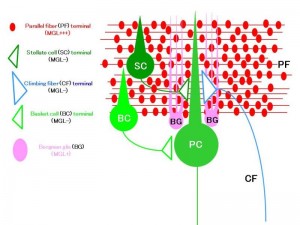Bulk disposal of endogenous marijuana-like substances in the brain Degradation mechanism in synaptic vicinity described


MGL is expressed only in the cytoplasm of parallel fiber (PF) terminals (red) and Bergmann glia (pink). ©Masanobu Kano
MGL is not expressed in climbing fiber (CF) terminals (blue) and stellate cell (SC) terminals (dark green), but it is thought that 2-AG acting here is hydrolyzed by MGL at surrounding PF and Bergmann glia. Additionally, it is expected that 2-AG acting at basket cells (BC) at locations distant from PF and Bergmann glia will be more difficult to be degraded by the action of MGL.
Increased neural activity in the brain triggers the postsynaptic release of the endocannabinoid 2-arachidonoylglycerol (2-AG), which has similar action to marijuana. Through retrograde signaling, 2-AG is known to inhibit the release of neurotransmitters at the synapse and to modulate the strength of synaptic transmission, but the mechanism by which it is removed from the synapse after completing its role remained unknown.
Professor Masanobu Kano at the University of Tokyo Graduate School of Medicine and his research group have confirmed that, out of the four types of synapses in the Purkinje cells of the cerebellum, monoacylglycerol lipase (MGL), the enzyme which degrades 2-AG, is present only in presynaptic terminals of parallel fibers and glial cells (Bergmann glia) near parallel fibers. Comparing normal mice with knockout mice that lack MGL, the researchers discovered that not only the 2-AG acting on MGL-rich parallel fiber synapses but also that acting on other MGL-deficient synapses were degraded similarly by MGL present in parallel fibers and surrounding Bergmann glia. In other words, even though MGL is present locally, it appears that the brain degrades 2-AG in a general and non-specific manner.
Blocking the action of MGL and suppressing the degradation of 2-AG to prolong its action may offer a new approach to developing a range of new anxiolytic, anti-depressive and analgesic medicines.
Press release (Japanese)Paper
Asami Tanimura, Motokazu Uchigashima, Maya Yamazaki, Naofumi Uesaka, Takayasu Mikuni, Manabu Abe, Kouichi Hashimoto, Masahiko Watanabe, Kenji Sakimura and Masanobu Kano,
“Synapse type-independent degradation of the endocannabinoid 2-arachidonoylglycerol after retrograde synaptic suppression”,
Proceedings of the National Academy of Sciences of the USA Online Edition: 2012/7/10 (Japan time), doi: 10.1073/pnas.1204404109.
Article link







